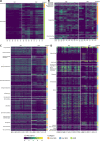Ocean-wide comparisons of mesopelagic planktonic community structures
- PMID: 37596349
- PMCID: PMC10439195
- DOI: 10.1038/s43705-023-00279-9
Ocean-wide comparisons of mesopelagic planktonic community structures
Abstract
For decades, marine plankton have been investigated for their capacity to modulate biogeochemical cycles and provide fishery resources. Between the sunlit (epipelagic) layer and the deep dark waters, lies a vast and heterogeneous part of the ocean: the mesopelagic zone. How plankton composition is shaped by environment has been well-explored in the epipelagic but much less in the mesopelagic ocean. Here, we conducted comparative analyses of trans-kingdom community assemblages thriving in the mesopelagic oxygen minimum zone (OMZ), mesopelagic oxic, and their epipelagic counterparts. We identified nine distinct types of intermediate water masses that correlate with variation in mesopelagic community composition. Furthermore, oxygen, NO3- and particle flux together appeared as the main drivers governing these communities. Novel taxonomic signatures emerged from OMZ while a global co-occurrence network analysis showed that about 70% of the abundance of mesopelagic plankton groups is organized into three community modules. One module gathers prokaryotes, pico-eukaryotes and Nucleo-Cytoplasmic Large DNA Viruses (NCLDV) from oxic regions, and the two other modules are enriched in OMZ prokaryotes and OMZ pico-eukaryotes, respectively. We hypothesize that OMZ conditions led to a diversification of ecological niches, and thus communities, due to selective pressure from limited resources. Our study further clarifies the interplay between environmental factors in the mesopelagic oxic and OMZ, and the compositional features of communities.
© 2023. ISME Publications B.V.
Conflict of interest statement
The authors declare no competing interests.
Figures





References
-
- Proud R, Cox MJ, Brierley AS. Biogeography of the global ocean’s mesopelagic zone. Curr Biol. 2017;27:113–9. - PubMed
-
- Robinson C, Steinberg DK, Anderson TR, Arístegui J, Carlson CA, Frost JR, et al. Mesopelagic zone ecology and biogeochemistry – a synthesis. Deep Sea Res Part II. 2010;57:1504–18.
-
- St. John MA, Borja A, Chust G, Heath M, Grigorov I, Mariani P, et al. A dark hole in our understanding of marine ecosystems and their services: perspectives from the mesopelagic community. Front Marine Sci. 2016;3:31.

